Genre: Sports Developer: Park Place Productions Publisher: Electronic Arts Players: 1-2 Released: 1990
Arcades were hopping in 1989, and loaded with awesome games that you couldn’t play at home on your Nintendo. When Sega released the Genesis in November of ’89 everything started to change. Electronic Arts had very little if anything to do with the arcades of the ’80s. Founded in 1982 EA concentrated primarily on PC games, eventually venturing into the sports genre on the Apple II computers with 1987’s Earl Weaver Baseball and then John Madden Football in 1988. The games were very different from the arcade sports games of the era such as 10 Yard Fight and Tecmo Bowl in many ways. Instead of challenging quick twitch reflexes, and hand eye coordination EA’s first of many batches of sports games relied heavily on cerebral strategy, and the ability to customize and tweak just about every aspect of the game in order to build an advantage for your squad. This strategy based game play design wasn’t very fun if you were unfamiliar with the complex sports of American baseball and football.
EA was a very important third party developer for Sega’s young Genesis in 1990. After reverse engineering the console upon launch, Trip Hawkins and co. had a thorough understanding of the hardware and managed to make up a huge chunk of the software released on the system for the first three years of its life. It was during these years that the roots of the modern day gaming empire of Electronic Arts were planted, and with their American football release of John Madden Football in 1990 they began to dabble in the arcade style of game play that Genesis gamers expected.
John Madden Football would’ve made a great arcade cabinet, The game is very simple and easy to learn how to play almost instantly. If you know absolutely nothing about American football, this is a great game to start out with. The controls are very simple, tight, responsive, and work quite well, if not better with an arcade joystick instead of a D-pad. The AI is downright stupid, so as is the case with most arcade games it is best enjoyed against a live opponent.
As far as features and gameplay modes, this one is as bare bones as it gets, contributing almost nothing at all to the game’s replay value. There is a sixteen-team playoff tournament for the “Madden Bowl,” but no stat tracking, and a password instead of a battery for game saves. Other than that all you get is a “sudden death” mode where whoever scores first wins the game. One complaint that I have with the gameplay is that the players are too slow. Even the fastest players in the game move pretty slow compared to later releases (’92/’93). Don’t get me wrong, other than the way the ball hangs in the air when passed, the game moves along at a nice pace, and the frame rate is consistent, but it seems as if you took a slow offensive linemen from Madden ’92 he would be the fastest player in this game.
The game’s graphics are a little rough compared to the much cleaner look of later 16-bit releases but definitely impressive for 1990. All twenty-two on screen player sprites are completely free of the sprite flicker that plagued the NES football games of the era, with rich, deep, if not somewhat inaccurate uniform colors. The players are just a little bit smaller, but are the same cartoony hand drawn style of player models that was reused for the next two games in the series. The animations, on the other hand, are horrible, especially the diving and tackling animations which consist of about one frame and are quite laughable. other things that may make you laugh in the game are the goofy, almost abstract hand drawn images of John Madden and the horrible sounds that the players make during gameplay.
During the entire game the players random screaming is just a little bit over the top. The hand full of voice samples in the game such as “it’s good” and “touchdown” sound surprisingly crisp, however they are the only bits of commentary in the game. As expected, John Madden Football is severely lacking in the presentation department. The pre-game options and playbook interfaces are very primitive. What little music there is in the game is quite forgettable, and the lack of the instant replay and coin toss ceremony signaled that “it” wasn’t quite “in the game” just yet.
A couple of big drawbacks are the game’s teams and rosters, something that usually makes a retro sports game worth playing again after all of these years. I mean, what better way to forget last years disappointing football season for Detroit Lions fans than to pop in that ’90s football game and rush for 1,000 yards a game with your trusty half back #20? What a great way to remember past glory when your favorite team hasn’t seen the post season in ages. Unfortunately, the first Genesis Madden is not only void of any real team names, logos or player names due to the lack of either the NFL or NFLPA licenses, but it doesn’t even have all twenty-eight teams from the ’89/’90 season, and none of the players are numbered or named anywhere in the game or instruction manual. Only sixteen teams were used (just enough for the tournament mode), and each is named after the city which it represents.
All of the powerhouses of the era are present such as back to back defending ’88 and ’89 Super Bowl champion San Francisco, perennial defensive juggernaut Chicago, defending AFC champion Denver, and soon-to-be Super Bowl champion New York (Giants, who went on to win Super Bowl XXV at the end of the 1990 season). Regular contenders during the ’80s such as Washington, Philadelphia, Los Angeles(rams), Minnesota, New England, Buffalo, Miami, Cincinnati, Houston, and Pittsburgh all make appearances as well. Two teams were put into the game as a hunch predating the franchises infamous pre season release “projections.”
On its own, John Madden Football is really a solid football game. It’s just amazing how far the developers were able to evolve the series in such a short amount of time, making this one completely obsolete. The games ’92 sequel improved almost every aspect, much like Streets Of Rage 2 and Shinobi III did for their respective prequels. without anything that even closely resembles the awesome, hall of fame filled ’89/’90 NFL rosters, and only a handful of teams there really isn’t a reason to own this game. Not to mention the slow game play, awkward sound effects and animations, primitive interface, beginner playbooks, and lack of any features such as a sixteen game season.
There really shouldn’t even be any kind of novelty in owning this game as it’s not even technically the first Madden football, it’s the second. It may be a lot more fun to play than the PC original, but all of the bells and whistles in that game such as the create-a-play, create-a-team, and team and playbook editor gave the original much more replay value. Add to this the fact that that game’s players had names, which contributed a great deal to the game’s charm. As much as I hate to say it, with the first John Madden Football on the genesis, we have a classic case of a game “aging” terribly.
SCORE: 6 out of 10

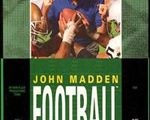
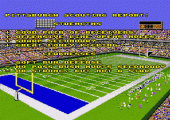
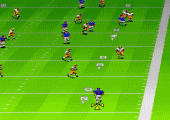
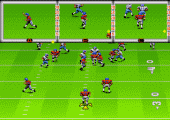
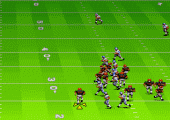
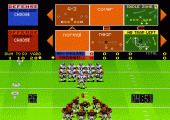
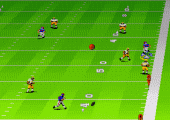
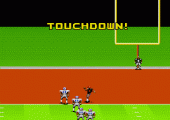
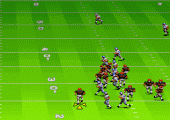
Recent Comments